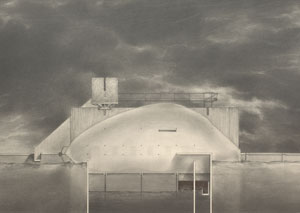The Douglas Darden Collection has been processed and is now available for researchers! This project was completed as a part of the Columbia Libraries Graduate Internship Program in Primary Sources by Sara McGillivray, a Master’s student in GSAPP’s CCCP Program.
Douglas Darden was an American architect based out of Denver, Colorado. He was best known for his book Condemned Building, an assembly of ten allegorical projects. The Archives’ collection contains much of Darden’s work for that book as well as the process work for his second book, Laughing Girls. It also contains a large portion of Darden’s early works and his professional papers, which lend background and context to his later work.

Born in Denver, Colorado in 1951, Darden studied ballet, before graduating with a Bachelors of English and Psychology from the University of Colorado at Boulder in 1974. His background in literature and dance translate into expressive works which rely on narrative structuring. Darden also studied Industrial Design at Parsons School of Design, and received his Masters of Architecture from the Harvard Graduate School of Design in 1983. He began work on the projects that would be later featured in Condemned Building, meanwhile, teaching at Harvard, then at the Catholic University of America, here at Columbia University, and later at the New Jersey Institute of Technology. Darden’s explorations of his industrial surroundings in New Jersey influenced the atmosphere of his work. Likewise, his time as a Fellow of the American Academy in Rome from (1988-9) gave him a deeper interest in the history and buildings of Rome.

Darden began teaching at the University of Colorado at Denver in 1990; it was at this time that he was diagnosed with leukemia. Darden continued to work through his illness, teaching and designing, and in 1993, Darden released Condemned Building. (Condemned Building is now out of print, but Avery Library does have a copy.) Although drawn in very detailed plan, section, and elevation, the projects in Condemned Building were unbuilt works, designed as allegorical structures only. Each project is described with a narrative akin to the acts in a play, describing the use of and circulation through each project. Darden’s process for these projects integrated visual and textual research, combining literary sources with the manipulation of graphic materials, and the Archives’ collection includes much of this work, in addition to the more well-known finished drawings featured in Darden’s book. This process work provides the researcher with an inside look into the allusions Darden tucks into each project from Duchamp, to Lequeu, to Piranesi, revealing his mischievous sense of humor.

Darden’s second book, Laughing Girls, moved further into narrative. Taking the form of a graphic architectural novel, Laughing Girls combined architectural drawing and collage with a storyline centered on three characters that moved from Troy, New York to Troy in Greece. Darden experimented with text and font, graphic images from his research and travels, and graphic elements converted from audio recordings. The Archives’ collection includes Darden’s research, studies, and drafts for Laughing Girls, however, the book was left unfinished when Darden’s leukemia returned; he passed away in April 1996.
In addition to teaching, Darden lectured and exhibited his works internationally. The Archives’ collection contains promotional material for many of these events, along with his faculty papers. The collection also includes many of Darden’s writings on architectural theory which were featured in a myriad of publications, and some which were never published, making it a valuable resource for anyone researching Darden, architectural theory, allegory, or narrative in architecture.

Thank you for doing this. I was so priveleged to be a student of Douglas Darden in the 1980s. His influence to approach all projects with absolute intensity and authenticity left a deep impression that would last a lifetime. He was a truly exceptional artist and man.
I was Douglas Darden’s partner from 1981-1985 and we remained close friends. I own some of his earliest drawings from when his time at the Harvard GSD pivoted from “traditional architecture” to the theoretical realm. We spent many weekends exploring places in Baltimore, where I was in graduate school, to prepare for his “Museum of Imposters.” We built his models together and I supported him as he began to apply for the Prix de Rome. I would love to see this collection at Columbia as many of those drawings were created in my presence!